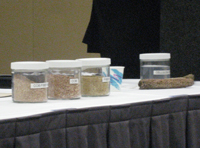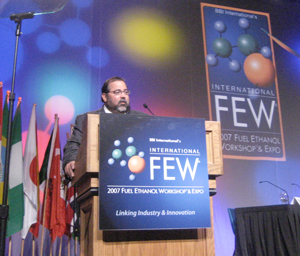 For a long time, Texas was known to be a leader in the non-renewable energy fields… in particular, the petroleum market. But it looks like the Lone Star State is now poised to dominate the green fuel picture as well.
For a long time, Texas was known to be a leader in the non-renewable energy fields… in particular, the petroleum market. But it looks like the Lone Star State is now poised to dominate the green fuel picture as well.
This story in the Houston Chronicle says Texas will lead the nation in renewable energy production by 2025, and could gain $22.8 billion in economic activity each year and more than 170,000 jobs overall:
The state’s energy production, which would supply about 4 percent of the U.S. needs in 2025, would come from biofuels, wind and solar power. Texas already leads the nation in wind energy production.
Texas’ projections come from a two-year study by the University of Tennessee Department of Agricultural Economics. The report, which looked at the 48 contiguous states, was commissioned by the National 25x’25 Alliance, a group working toward having 25 percent of the country’s energy come from renewable sources by 2025.
If the report’s estimates pan out, the economic impact nationwide in 2025 will be $700 billion annually and create 5.1 million jobs, mostly in rural areas.
Ironically, Texas Governor Rick Perry and the state legislature are, so far, are unwilling to sign on to that national “25 by 25” effort.


 One of the award winners, Macon Municipal Utilities reduced their energy use by 25 percent. Macon Municipal Utilities installed a 10 megawatt (MW) natural gas-fired combustion turbine CHP system at its 45 million gallon-per-year ethanol plant in Northeast Missouri. The CHP system will likely reduce greenhouse gas emissions by an estimated 28,000 tons per year, which is equivalent to the annual emissions of more than 4,500 cars.
One of the award winners, Macon Municipal Utilities reduced their energy use by 25 percent. Macon Municipal Utilities installed a 10 megawatt (MW) natural gas-fired combustion turbine CHP system at its 45 million gallon-per-year ethanol plant in Northeast Missouri. The CHP system will likely reduce greenhouse gas emissions by an estimated 28,000 tons per year, which is equivalent to the annual emissions of more than 4,500 cars. At its 40 million gallon-per-year ethanol plant in Illinois, Adkins Energy LLC, decreased their energy use by 15 percent with a 5 MW natural gas-fired combustion turbine CHP system. The CHP system reduces greenhouse gas emissions by an estimated 8,700 tons per year, which is equivalent to the annual emissions of 1,400 cars.
At its 40 million gallon-per-year ethanol plant in Illinois, Adkins Energy LLC, decreased their energy use by 15 percent with a 5 MW natural gas-fired combustion turbine CHP system. The CHP system reduces greenhouse gas emissions by an estimated 8,700 tons per year, which is equivalent to the annual emissions of 1,400 cars. Thanks to the
Thanks to the  In an effort to be more friendly to the planet, Prince Charles says he is using biodiesel in a couple of his personal vehicles… and might even use the green fuel on the Royal Train.
In an effort to be more friendly to the planet, Prince Charles says he is using biodiesel in a couple of his personal vehicles… and might even use the green fuel on the Royal Train. “We identified the metabolic processes and conditions that allow a known strain of E. coli to convert glycerin into ethanol,” said chemical engineer Ramon Gonzalez. “It’s also very efficient. We estimate the operational costs to be about 40 percent less that those of producing ethanol from corn.”
“We identified the metabolic processes and conditions that allow a known strain of E. coli to convert glycerin into ethanol,” said chemical engineer Ramon Gonzalez. “It’s also very efficient. We estimate the operational costs to be about 40 percent less that those of producing ethanol from corn.” Consolidated Biofuels and International Bio Fuels Corp. have announced plans to jointly open a biodiesel plant in Arkansas… one that will be among the biggest in the country.
Consolidated Biofuels and International Bio Fuels Corp. have announced plans to jointly open a biodiesel plant in Arkansas… one that will be among the biggest in the country. The refinery will be built on a 65 acre lot on the Mississippi Port of Yellow Bend and will produce 150 million gallons of biodiesel and 70 million bushels of soybean oil crush annually.
The refinery will be built on a 65 acre lot on the Mississippi Port of Yellow Bend and will produce 150 million gallons of biodiesel and 70 million bushels of soybean oil crush annually. 
 “This technology is a significant milestone in helping increase ethanol output per acre,” said Russ Sanders, Pioneer Director of Marketing. “In FOSS instruments, the Pioneer Ethanol Yield Potential Calibration provides nearly instant prediction of ethanol yield potential in corn grain and provides an estimated yield in gallons per bushel terms.”
“This technology is a significant milestone in helping increase ethanol output per acre,” said Russ Sanders, Pioneer Director of Marketing. “In FOSS instruments, the Pioneer Ethanol Yield Potential Calibration provides nearly instant prediction of ethanol yield potential in corn grain and provides an estimated yield in gallons per bushel terms.” At the 2007 Fuel Ethanol Workshop in St. Louis on Wednesday, the nation’s largest dry-mill ethanol producer announced the successful production of cellulosic ethanol from corn cobs.
At the 2007 Fuel Ethanol Workshop in St. Louis on Wednesday, the nation’s largest dry-mill ethanol producer announced the successful production of cellulosic ethanol from corn cobs.  At a press conference,
At a press conference,  Dr. Mark Stowers, VP of Research & Development for POET, says they expect the use of corn cobs for ethanol production to result in an 11 percent increase in the amount of ethanol per bushel of corn. “And when you look at it on an acreage basis, that’s about 27 percent more ethanol per acre.”
Dr. Mark Stowers, VP of Research & Development for POET, says they expect the use of corn cobs for ethanol production to result in an 11 percent increase in the amount of ethanol per bushel of corn. “And when you look at it on an acreage basis, that’s about 27 percent more ethanol per acre.” Just a few ethanol industry pioneers were present at the first Fuel Ethanol Workshop in St. Louis some 23 years ago.
Just a few ethanol industry pioneers were present at the first Fuel Ethanol Workshop in St. Louis some 23 years ago.